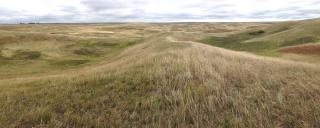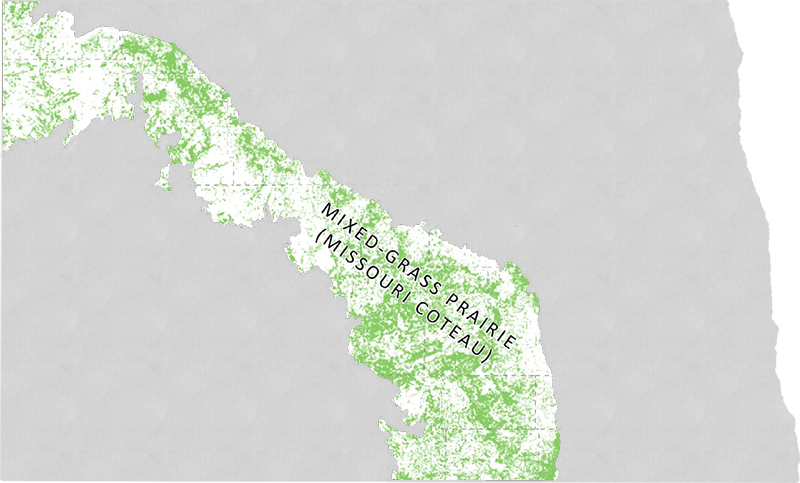
Mixed-grass Prairie (Missouri Coteau)
Area: 10,215,000 acres or 15,960 mi²
Description and Overall Condition: This landscape component includes the mixed-grass prairie of the Missouri Coteau and associated wetlands. This region marks the boundary of the western limits of glaciation in North Dakota. The hummocky, rolling hills of the Missouri Coteau dramatically rise 150 to 500 feet above the Drift Prairie. A high concentration of wetlands are present, roughly 800,000 basin acres. Alkaline lakes are also more prevalent here.
Streams and rivers are nearly absent, as are upland deciduous forests but tracts of aspen parkland occur in the north. A considerable amount of native prairie remains and there is extensive cattle grazing. Areas of reduced slope, particularly the western edge, have been converted to cropland such as small grains, sunflowers, corn, and alfalfa hayland. The Coteau is known for supporting some of the highest numbers of breeding ducks in North America. Due to the large amount of grassland and wetlands which remain or have been restored, this area is especially crucial to many species of grassland wildlife and constitutes the focus area “Missouri Coteau Breaks.” Much of the Coteau is classified as good to outstanding for wind energy potential, which could pose the threat of habitat fragmentation. Irrigation and new advances in cropland could allow for native prairie to be farmed. Oil and gas activity is established in the extreme northwest.
Predominant Natural Vegetation
Grasses
prairie junegrass, little bluestem, needle-and-thread, blue grama, green needlegrass, porcupine grass, prairie cordgrass, Northern reedgrass, plains muhly, Wastern wheatgrass, Kentucky bluegrass
Forbs
pasque flower, torch flower, yarrow, gumweed, golden aster, prairie rose, Missouri milkvetch, purple loco, lead plant, Indian breadroot, purple prairie-clover, gaura, hairy puccoon, harebell, goldenrod, smooth fleabane, perennial ragweed, purple coneflower, upland wormwood, green sage and fringed sage.
Associated Species of Conservation Priority
Birds
American bittern, northern pintail, lesser scaup, northern harrier, american kestrel, swainson’s hawk, ferruginous hawk, sharp-tailed grouse, willet, upland sandpiper, marbled godwit, wilson’s phalarope, franklin’s gull, black tern, short-eared owl, loggerhead shrike, sedge wren, sprague’s pipit, lark bunting, grasshopper sparrow, baird’s sparrow, le conte’s sparrow, nelson’s sparrow, chestnut-collared longspur, dickcissel, bobolink, western meadowlark
Mammals
arctic shrew, richardson’s ground squirrel
Reptiles/Amphibians
plains spadefoot, canadian toad, smooth green snake, plains hog-nosed snake
Insects
dakota skipper, monarch butterfly, regal fritillary
Other Characteristic Wildlife
Birds
American wigeon, green-winged teal, mallard, blue-winged teal, Northern shoveler, gadwall, lesser caup, red-tailed hawk, American kestrel, gray partridge, ring-necked pheasant, spotted sandpiper, killdeer, mourning dove, common nighthawk, Western kingbird, Eastern kingbird, horned lark, American crow, Eastern bluebird, common yellowthroat, clay-colored sparrow, vesper sparrow, Savannah sparrow, Western meadowlark, brown-headed cowbird
Mammals
white-tailed jackrabbit, snowshoe hare, thirteen-lined ground squirrel, Northern pocket gopher, olive-backed pocket mouse, Western harvest mouse, deer mouse, Northern grasshopper mouse, prairie vole, meadow vole, meadow jumping mouse, coyote, red fox, raccoon, badger, striped skunk, white-tailed deer
Reptiles/Amphibians
Great Plains toad, Woodhouse’s toad, Northern leopard frog, chorus frog, tiger salamander, plains garter snake, common garter snake, yellowbelly racer, bullsnake
For more detailed information about this topic, please see the North Dakota Wildlife Action Plan.

